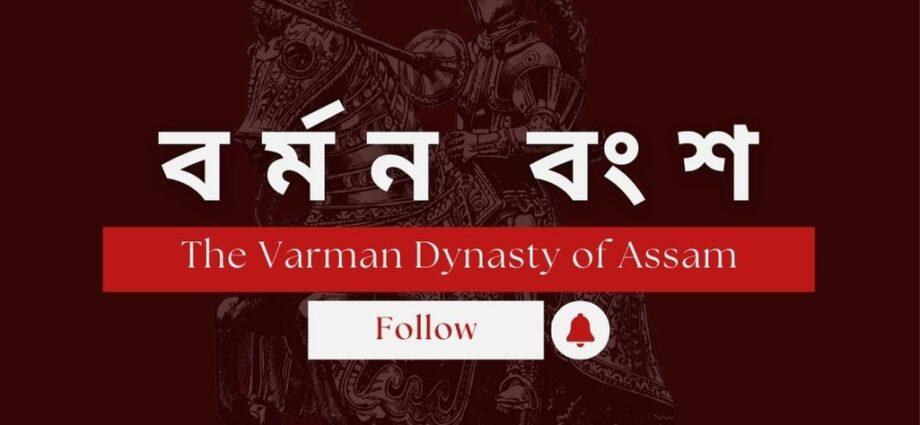The Varman Dynasty
(অসমীয়াত পঢ়িবলৈ তললৈ Scroll কৰক)
The political history of Assam dates back to the reign of the Burman dynasty. In prehistoric Assam, we found Austrian Asians. There is no historical evidence of the entry of the Mongoloids into Assam and the establishment of the dynasties of Danava and Asuras. It is mentioned only in mythological texts. However, old inscriptions and copper plates found in Assam show that the political history of Assam began with the establishment of the Burman dynasty. The Burman dynasty ruled Assam for about three hundred years from 350 AD to 650 AD. During their reign, the kingdom was called Kamarupa and the capital was called Pragajyotispur. The main language of the people of Kamrup was Sanskrit and Kamrupi Pakrit during the reign of the Varman dynasty founded by Pushya Varman. The founding king, Pushya Varman, took the title of Maharajadhiraj. The last and greatest king of the Burman dynasty was Kumara Bhaskar Burman. While the Burman dynasty ruled Kamarupa, the famous Gupta Empire ruled northern India. Samudragupta was the king of the Gupta Empire and a contemporary of Pushya Varman.
There are many examples of the influence of the Gupta Empire on the kingdom of Kamrup. The kings of the Gupta Empire also took the title of Maharajadhiraj. The architecture of the Da- Da-Parbatiya near Tezpur is similar to the Gupta architecture. The architecture of the Da-Parbatiya is the oldest architectural sculpture found in Assam.
The kings of the Burman dynasty
Pushyabarman – Samudrabarman – Balavarman – Kalyan Barman – Ganapati Barman – Mahendra Barman – Narayan Barman – Bhuti Barman – Chandramukh Barman – Sthita Barman – Susthita Barman(Sri Mrigank) – Supratisthita Barman – Kumar Bhaskar Barman
Amritaprabha was the daughter of King Balabarman of the Burman dynasty. Amrita Prabha was married to Prince Meghbahan of Kashmir. This is mentioned in the Rajatarangini of Pandit Kalhan of Kashmir. Amritaprabha got married and built some Buddhist temples in Kashmir. It was called Amrit Bhavan
The next king after Balabarman was Kalyan Barman. It was during the reign of Kalyan Burman that the Davaka Kingdom came under the rule of the Kingdom of Kamrup. Kalyan Burman was a politically skilled king. At the same time, he sent diplomatic envoys to China. Another notable king of the Burman dynasty was Mahendra Barman. He was the first to complete the Ashvamedha Yagya in Assam. Earlier, Balabarman had also performed an Ashwamedha sacrifice but he was unsuccessful. Mahendra Barman conquered the Pundravardhana region of Bengal. During the reign of the kings of the Burman dynasty, it was customary to donate land to Brahmins. This land was donated to the Brahmins and was called Brahmadeya..
Kumar Bhaskar Burman
The greatest king of the Barman dynasty was Kumara Bhaskar Barman. Assamese Year Bhaskarabda was started during his period. Harshavardhana, king of Kanauj, was a contemporary of Bhaskar Barman. Bhaskar Barman and Harshavardhan were good friends. Bhaskar Barman sent a Kataki named Hansabeg to Kanauj. Bhaskar Barman defeated Shashanka, king of Gaura, at the Battle of Karnasuvarna and recovered the Pundravardhana region. Karnasuvarna was the capital of Gaura at that time. Harshavardhana helped Bhaskar Barman in this battle.
During the reign of Bhaskar Barman, two Chinese emigrants named Huyen Tsang and Li Yi Piao visited Kamrup. Huyen Tsang came to study Buddhism at Nalanda University. Silabhadra was the Director of Nalanda University at that time. Huyen Tsang came to visit Kamrup on the advice of Silabhadra. He described his experience of this trip in a note called Si-Yu-Ki. The note tells us many things about Assam at that time.
According to the Si-Yu-Ki, the main industry of Kamrup at that time was the boat-building industry. The kings of the Barman dynasty were Brahmins and the King Bhaskar Barman were devotees of Shiva. In his book Si-yu-ki, Huyen Tsang mentioned the name of Kamrup as Kam0-lu-pu. He said that the circumference of Kamrup was 1700 miles or 10000 li. Huyen Tsang also wrote that the people of Kamrup were short and dark yellow in color. There are two types of fruits used in religious ceremonies by the people of Kamrup at that time – jackfruit and coconut. During the reign of Bhaskar Barman, the extent of Kamarupa was quite large. The work of the time extended to Bihar in the west and to Tripura and Sylhet in Bangladesh in the south. Huyen Tsang wrote that the port Tamrolipti of the Bay of Bengal was also under the rule of Kamrup at that time.
In 1917-18, the excavations of the Nalanda University by Dr. David B Spooner discovered a seal of the time of Bhaskar Barman. The biography of Harshavardhana by Banbhatta, “Harshacharita”, also contains various information about Bhaskar Barman. In addition, the Dubi copperplate, Nidhanpur copperplate, Umachal inscription, Nagajari-Khanikargaon inscription etc. date back to the time of the Barman dynasty or Bhaskar Burman. These inscriptions have helped historians to understand about the Kamrup of that time.
বৰ্মন বংশ (The Varman Dynasty)
দৰাচলতে অসমৰ ৰাজনৈতিক ইতিহাস বৰ্মন বংশৰ ৰাজত্বকালৰ পৰাই আৰম্ভ হৈছে। প্ৰাগঐতিহাসিক অসমত আমি অষ্ট্ৰো এছিয়াতিক সকলক পাইছিলোঁ। অসমত মংগোলয়ডসকলৰ প্ৰৱেশ আৰু দানৱ আৰু অসুৰ বংশ প্ৰতিষ্ঠাৰ কোনো ঐতিহাসিক প্ৰমাণ পোৱা নাযায়। ইয়াৰ উল্লেখ কেৱল পৌৰাণিক গ্ৰন্থসমূহতহে পোৱা যায়। কিন্তু অসমত পোৱা পুৰণি শিলালিপি আৰু তামৰ ফলকবোৰৰ পৰা স্পষ্ট হৈ পৰে যে বৰ্মন বংশৰ প্ৰতিষ্ঠাৰ পৰাই অসমৰ ৰাজনৈতিক ইতিহাস আৰম্ভ হৈছিল।
৩৫০ খ্ৰীষ্টাব্দৰ পৰা ৬৫০ খ্ৰীষ্টাব্দলৈ প্ৰায় তিনিশ বছৰ ধৰি বৰ্মন বংশই অসমত শাসন কৰিছিল। তেওঁলোকৰ ৰাজত্বকালত ৰাজ্যখনৰ নাম কামৰূপ আৰু ৰাজধানীক প্ৰাগজ্যোতিষপুৰ বুলি কোৱা হৈছিল। পূষ্য বর্মনে প্রতিষ্ঠা কৰা বর্মন বংশৰ দিনত কামৰূপবাসীৰ প্রধান ভাষা আছিল সংস্কৃত আৰু কামৰূপী পকৃত৷ প্ৰতিষ্ঠাপক ৰজা পূষ্য বৰ্মনে মহাৰাজাধিৰাজ উপাধি গ্ৰহণ কৰিছিল। বৰ্মন বংশৰ শেষ আৰু সৰ্বশ্ৰেষ্ঠ ৰজা আছিল কুমাৰ ভাস্কৰ বৰ্মন।
যি সময়ত বৰ্মন বংশই কামৰূপত শাসন কৰিছিল, সেই সময়ত বিখ্যাত গুপ্ত সাম্ৰাজ্যই উত্তৰ ভাৰতত শাসন কৰিছিল। সমুদ্ৰগুপ্ত আছিল পূষ্য বৰ্মানৰ সমসাময়িক গুপ্ত সাম্ৰাজ্যৰ ৰজা। আৰু এই সকলোবোৰ তথ্য এলাহাবাদৰ স্তম্ভত পোৱা যায়। এলাহাবাদ স্তম্ভত উল্লেখ আছে যে সেই সময়ত অসমত দুখন ৰাজ্য আছিল – কামৰূপ আৰু মধ্য অসমৰ ফালে ডবকা । বৰ্মন বংশৰ আৰম্ভণিতে কামৰূপ ৰাজ্য গুপ্ত সাম্ৰাজ্যৰ অধীনত আছিল বুলিও এলাহাবাদ স্তম্ভত উল্লেখ আছে।
কামৰূপ ৰাজ্যৰ ওপৰত গুপ্ত সাম্ৰাজ্যৰ প্ৰভাৱৰ বহু উদাহৰণ আছে। গুপ্ত সাম্ৰাজ্যৰ ৰজাসকলেও মহাৰাজাধিৰাজ উপাধি গ্ৰহণ কৰিছিল। তেজপুৰৰ সমীপৰ ডা-পৰ্বতীয়াৰ স্থাপত্য গুপ্ত স্থাপত্যৰ সৈতে মিল আছে। ড-পৰ্বতিয়াৰ স্থাপত্য অসমত পোৱা আটাইতকৈ পুৰণি স্থাপত্য ভাস্কৰ্য্য।
বৰ্মন বংশৰ ৰজা সকল
পূষ্যবৰ্মন – সমুদ্ৰবৰ্মন – বলবৰ্মন – কল্যাণ বৰ্মন – গণপতি বৰ্মন – মহেন্দ্ৰ বৰ্মন – নাৰায়ণ বৰ্মন – ভূতি বৰ্মন – চন্দ্ৰমুখ বৰ্মন – স্থিত বৰ্মন – সুস্থিত বৰ্মন (শ্ৰী মৃগাংক) – সুপ্ৰতিস্থিত বৰ্মন – কুমাৰ ভাস্কৰ বৰ্মন ।
বৰ্মন বংশৰ ৰজা বলবৰ্মনৰ জীয়েক আছিল অমৃতপ্ৰভা । অমৃতপ্ৰভা বিয়া হৈছিল কাশ্মীৰৰ ৰাজকুমাৰ মেঘবাহনৰ লগত । কাশ্মীৰৰ পণ্ডিত কলহনৰ ৰাজতৰংগীনিত এই কথাৰ উল্লেখ পোৱা যায় । অমৃতপ্ৰভা বিয়া হৈ গৈ কাশ্মীৰত কিছুমান বৌদ্ধ মন্দিৰ বনোৱাইছিল । যাক কোৱা হৈছিল অমৃতভৱন ।
বলবৰ্মনৰ পিছত পৰৱৰ্তী ৰজা আছিল কল্যাণ বৰ্মন। কল্যাণ বৰ্মনৰ দিনতেই দৱকা কামৰূপ ৰাজ্যৰ শাসনৰ অধীনলৈ আহে। কল্যাণ বৰ্মন আছিল ৰাজনৈতিকভাৱে সুদক্ষ ৰজা। একে সময়তে তেওঁ চীনলৈ কূটনৈতিক দূত প্ৰেৰণ কৰে। বৰ্মন বংশৰ আন এজন উল্লেখযোগ্য ৰজা আছিল মহেন্দ্ৰ বৰ্মন। অসমত তেওঁ প্ৰথমে অশ্বমেধ যজ্ঞ সফলতাৰে সম্পূৰ্ণ কৰিছিল। ইয়াৰ পূৰ্বে বলবৰ্মনেও অশ্বমেধ যজ্ঞ কৰিছিল যদিও তেওঁ সফল নহল। মহেন্দ্ৰ বৰ্মনে বংগৰ অধীনত থকা পুন্দ্ৰবৰ্ধন অঞ্চল জয় কৰে। বৰ্মন বংশৰ ৰজাসকলৰ ৰাজত্বকালত ব্ৰাহ্মণক মাটি দান কৰাৰ প্ৰথা আছিল। ব্ৰাহ্মণক দান কৰা এই মাটিক ব্ৰহ্মদেৱা বুলি কোৱা হৈছিল।
কুমাৰ ভাস্কৰ বৰ্মন
বৰ্মণ বংশৰ সৰ্বশ্ৰেষ্ঠ ৰজা আছিল কুমাৰ ভাস্কৰ বৰ্মন। অসমীয়া বছৰ ভাস্কৰব্দ তেওঁৰ সময়ৰ পৰাই আৰম্ভ হৈছিল। কনৌজৰ ৰজা হৰ্ষবৰ্ধন ভাস্কৰ বৰ্মনৰ সমসাময়িক আছিল। ভাস্কৰ বৰ্মন আৰু হৰ্ষবৰ্ধন ভাল বন্ধু আছিল। ভাস্কৰ বৰ্মনে কনৌজলৈ হংসবেগ নামৰ কটকী এজনী পঠাইছিল। ভাস্কৰ বৰ্মনে কৰ্ণসুবৰ্ণ যুদ্ধত গৌড়ৰ ৰজা শশংকক পৰাস্ত কৰি পুন্দ্ৰবৰ্ধন অঞ্চল উদ্ধাৰ কৰে। সেই সময়ত কৰ্ণসুবৰ্ণ গৌড়ৰ ৰাজধানী আছিল। এই যুদ্ধত হৰ্ষবৰ্ধনে ভাস্কৰ বৰ্মনক সহায় কৰিছিল।
ভাস্কৰ বৰ্মনৰ দিনত হিউয়েন ছাং আৰু লি য়ি পিয়াও নামৰ দুজন চীনা প্ৰব্ৰজনকাৰীয়ে কামৰূপ ভ্ৰমণ কৰিছিল। আচলতে হিউয়েন ছাং নালন্দা বিশ্ববিদ্যালয়ত বৌদ্ধ ধৰ্ম অধ্যয়ন কৰিবলৈ আহিছিল। শিলভদ্ৰ সেই সময়ত নালন্দা বিশ্ববিদ্যালয়ৰ সঞ্চালক আছিল। শিলভদ্ৰৰ পৰামৰ্শ মতে কামৰূপলৈ আহিছিল হিউয়েন ছাং। এই ভ্ৰমণৰ অভিজ্ঞতা তেওঁ ছি-ইউ-কি নামৰ এখন টোকাত বৰ্ণনা কৰিছিল। সেই সময়ৰ অসমৰ বহু কথাই ছি-ইউ-কিত কোৱা হৈছে।
ছি-ইউ-কিত উল্লেখ থকা মতে সেই সময়ৰ কামৰূপৰ প্ৰধান উদ্যোগ আছিল নাঁও বনোৱা উদ্যোগ । বৰ্মন বংশৰ ৰজা সকল ব্ৰাহ্মণ আছিল আৰু ৰজা ভাস্কৰ বৰ্মন আছিল শিৱ ভক্ত । হিউয়েন ছাঙে তেঁওৰ কিতাপ ছি-ইউ-কিত কামৰূপৰ নাম কাম-লু-পু (Kamo-Lu-Pu)বুলি উল্লেখ কৰিছিল । তেঁও কামৰূপৰ পৰিধী ১৭০০ মাইল বা ১০০০০ লি বুলি কৈছিল । কামৰূপৰ মানুহ বোৰ চুতি চাপৰ আৰু গাৰ ৰং ডাঠ হালধীয়া বুলিও হিউয়েন ছাঙে লিখি থৈ গৈছিল । সেই সময়ৰ কামৰূপৰ মানুহে ধৰ্মীয় অনুষ্ঠান আদিত দুবিধ ফলৰ ব্যবহাৰ কৰিছিল – কঠাল আৰু নাৰিকল । ভাস্কৰ বৰ্মনৰ সময়ত কামৰূপৰ পৰিসীমা যঠেষ্ট দাঙৰ আছিল । পশ্চিমে বিহাৰলৈ আৰু দক্ষীনে ত্ৰিপুৰা আৰু বাংলাদেশৰ ছিলেটলৈ বিয়পি আছিল সেই সময়ৰ কামৰূপ । বংগোপ সাগৰৰ বন্দৰ তাম্ৰলীপ্তিও সেই সময়ত কামৰূপৰ অধিনত আছিল বুলি হিউয়েন ছাঙে লিখি থৈ গৈছিল ।
১৯১৭-১৮ চনত ড° ডেভিদ বি স্পুনাৰে নালন্দা বিশ্ববিদ্যালয়ৰ খননত ভাস্কৰ বৰ্মনৰ সময়ৰ এটা ছীল আৱিষ্কাৰ হয়। বনভট্টৰ দ্বাৰা ৰছিত হৰ্ষবৰ্ধনৰ জীৱনী “হৰ্ষচৰিত”তো ভাস্কৰ বৰ্মনৰ বিষয়ে বিভিন্ন তথ্য সন্নিবিষ্ট কৰা হৈছে। তদুপৰি ডুবি তামৰ ফলক, নিধানপুৰ তামৰ ফলক, উমাচল শিলালিপি, নাগাজাৰী-খানিকৰগাঁও শিলালিপি আদিও বৰ্মন বংশ বা ভাস্কৰ বৰ্মনৰ সময়ৰ। এই শিলালিপিসমূহে ইতিহাসবিদসকলক সেই সময়ৰ কামৰূপৰ বিষয়ে বুজিবলৈ সহায় কৰিছে।
Click Here for the Previous Year’s APSC Question Paper
Moreover, your support has been invaluable to us. We are grateful for your continued support…
Follow us on

